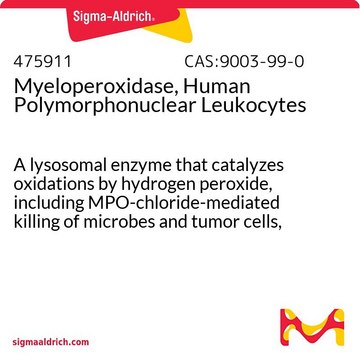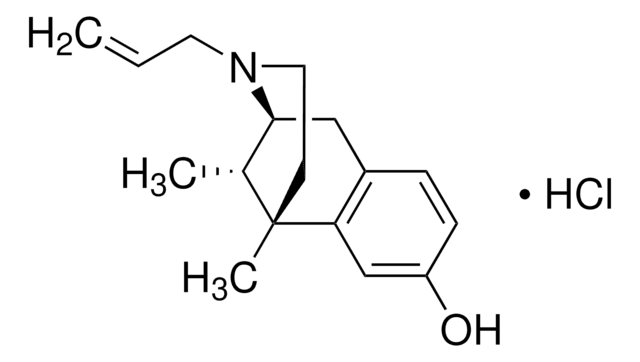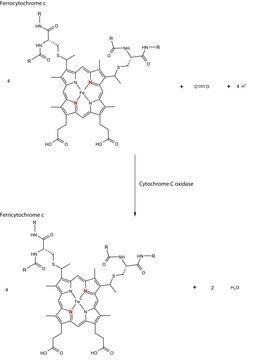Alle Fotos(1)
Wichtige Dokumente
A3672
Azurin aus Pseudomonas aeruginosa
from Pseudomonas aeruginosa, lyophilized powder
Anmeldenzur Ansicht organisationsspezifischer und vertraglich vereinbarter Preise
Alle Fotos(1)
About This Item
Empfohlene Produkte
Biologische Quelle
Pseudomonas aeruginosa
Qualitätsniveau
Form
lyophilized powder
Zusammensetzung
Protein, ≥65% Lowry
Konzentration
≥65.0% (Lowry)
Methode(n)
toxicology assay: suitable
Löslichkeit
water: soluble 1—1.1 mg/mL, clear, blue (light blue to blue)
UniProt-Hinterlegungsnummer
Lagertemp.
−20°C
Angaben zum Gen
Pseudomonas aeruginosa ... AZU(878046)
Suchen Sie nach ähnlichen Produkten? Aufrufen Leitfaden zum Produktvergleich
Allgemeine Beschreibung
Research area: Apoptosis. Azurinis a periplasmic protein and is a homotetramer.
Anwendung
Azurin has been used:
- in the cytotoxicity and cell viability studies in human osteosarcoma cell line
- for the functionalization of silicon nitride cantilevers for interaction studies
- for coating gold surface and insulating functionalized oxide surfaces of silicon oxide and mica
Biochem./physiol. Wirkung
Azurin acts as an electron donor for nitrite reductase in bacterial denitrification process. It exhibits anticancer activity as it hampers various independent signaling pathways associated with cancer progression. It binds to tumor suppressor protein p53 and induces cancer cell apoptosis or stalls cancer cell growth. Azurin disrupts angiogenesis by reducing the activity of VEGFR-2tyrosine kinase thereby inhibiting tumor growth. It has been observed to show cytotoxicity in human breast cancer cells and human melanoma cells.
Azurin is a metalloprotein in the family of cupredoxins. It preferentially enters cancer cells over normal cells and induces apoptosis. Azurin has structural similarities to ephrinB2, and in fact binds the ephrin receptor tyrosine kinase EphB2 to initiate cell signaling that is involved in cancer progression. Azurin inhibits autophosphorlyation of the EphB2 tyrosine residue, interfering with upstream cell signaling and contributing to cancer cell growth inhibition.
Physikalische Form
Lyophilized powder containing ammonium acetate buffer salts.
Lagerklassenschlüssel
11 - Combustible Solids
WGK
WGK 3
Flammpunkt (°F)
Not applicable
Flammpunkt (°C)
Not applicable
Persönliche Schutzausrüstung
Eyeshields, Gloves, type N95 (US)
Hier finden Sie alle aktuellen Versionen:
Besitzen Sie dieses Produkt bereits?
In der Dokumentenbibliothek finden Sie die Dokumentation zu den Produkten, die Sie kürzlich erworben haben.
Yunlei Zhang et al.
Applied and environmental microbiology, 78(21), 7603-7610 (2012-08-28)
Many studies have demonstrated that intravenously administered bacteria can target and proliferate in solid tumors and then quickly be released from other organs. Here, we employed the tumor-targeting property of Escherichia coli Nissle 1917 to inhibit mouse B16 melanoma and
Krzysztof Kazimierczuk et al.
Journal of magnetic resonance (San Diego, Calif. : 1997), 223, 1-10 (2012-09-11)
The resolution of multidimensional NMR spectra can be severely limited when regular sampling based on the Nyquist-Shannon theorem is used. The theorem binds the sampling rate with a bandwidth of a sampled signal and thus implicitly creates a dependence between
Bacterial redox protein azurin induce apoptosis in human osteosarcoma U2OS cells
Yang DS, et al.
Pharmacological Research, 52(5), 413-421 (2005)
Ajay Kumar Yagati et al.
Biosensors & bioelectronics, 40(1), 283-290 (2012-08-14)
We developed a nanoscale memory device consisting of signal-responsive biomaterial, which is capable of switching physical properties (such as electrical/electrochemical, optical, and magnetic) upon application of appropriate electrical signals to perform memory switching. Here, we propose a highly robust surface-confined
Daniel Raimunda et al.
Metallomics : integrated biometal science, 5(2), 144-151 (2013-01-29)
Pseudomonas aeruginosa, an opportunistic pathogen, has two transmembrane Cu(+) transport ATPases, CopA1 and CopA2. Both proteins export cytoplasmic Cu(+) into the periplasm and mutation of either gene leads to attenuation of virulence. CopA1 is required for maintaining cytoplasmic copper levels
Unser Team von Wissenschaftlern verfügt über Erfahrung in allen Forschungsbereichen einschließlich Life Science, Materialwissenschaften, chemischer Synthese, Chromatographie, Analytik und vielen mehr..
Setzen Sie sich mit dem technischen Dienst in Verbindung.








